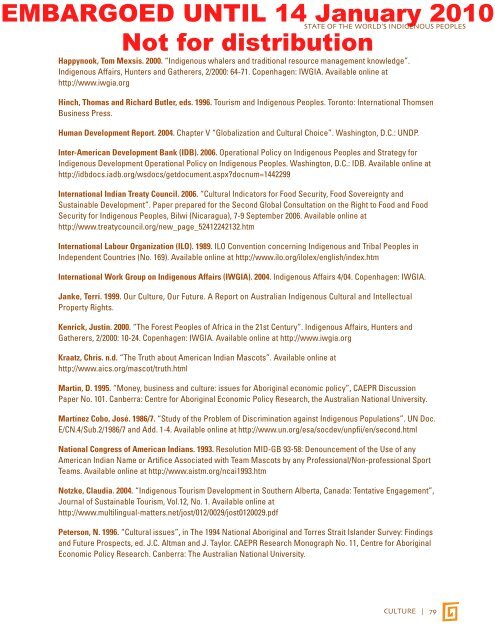STATE OF THE WORLD's INDIGENOUs PEOpLEs - CINU
STATE OF THE WORLD's INDIGENOUs PEOpLEs - CINU
STATE OF THE WORLD's INDIGENOUs PEOpLEs - CINU
- No tags were found...
You also want an ePaper? Increase the reach of your titles
YUMPU automatically turns print PDFs into web optimized ePapers that Google loves.
EMBARGOED UNTIL 14 January 2010<strong>STATE</strong> <strong>OF</strong> <strong>THE</strong> WORLD’S INDIGENOUS PEOPLESNot for distributionHappynook, Tom Mexsis. 2000. “Indigenous whalers and traditional resource management knowledge”.Indigenous Affairs, Hunters and Gatherers, 2/2000: 64-71. Copenhagen: IWGIA. Available online athttp://www.iwgia.orgHinch, Thomas and Richard Butler, eds. 1996. Tourism and Indigenous Peoples. Toronto: International ThomsenBusiness Press.Human Development Report. 2004. Chapter V “Globalization and Cultural Choice”. Washington, D.C.: UNDP.Inter-American Development Bank (IDB). 2006. Operational Policy on Indigenous Peoples and Strategy forIndigenous Development Operational Policy on Indigenous Peoples. Washington, D.C.: IDB. Available online athttp://idbdocs.iadb.org/wsdocs/getdocument.aspx?docnum=1442299International Indian Treaty Council. 2006. “Cultural Indicators for Food Security, Food Sovereignty andSustainable Development”. Paper prepared for the Second Global Consultation on the Right to Food and FoodSecurity for Indigenous Peoples, Bilwi (Nicaragua), 7-9 September 2006. Available online athttp://www.treatycouncil.org/new_page_52412242132.htmInternational Labour Organization (ILO). 1989. ILO Convention concerning Indigenous and Tribal Peoples inIndependent Countries (No. 169). Available online at http://www.ilo.org/ilolex/english/index.htmInternational Work Group on Indigenous Affairs (IWGIA). 2004. Indigenous Affairs 4/04. Copenhagen: IWGIA.Janke, Terri. 1999. Our Culture, Our Future. A Report on Australian Indigenous Cultural and IntellectualProperty Rights.Kenrick, Justin. 2000. “The Forest Peoples of Africa in the 21st Century”. Indigenous Affairs, Hunters andGatherers, 2/2000: 10-24. Copenhagen: IWGIA. Available online at http://www.iwgia.orgKraatz, Chris. n.d. “The Truth about American Indian Mascots”. Available online athttp://www.aics.org/mascot/truth.htmlMartin, D. 1995. “Money, business and culture: issues for Aboriginal economic policy”, CAEPR DiscussionPaper No. 101. Canberra: Centre for Aboriginal Economic Policy Research, the Australian National University.Martínez Cobo, José. 1986/7. “Study of the Problem of Discrimination against Indigenous Populations”. UN Doc.E/CN.4/Sub.2/1986/7 and Add. 1-4. Available online at http://www.un.org/esa/socdev/unpfii/en/second.htmlNational Congress of American Indians. 1993. Resolution MID-GB 93-58: Denouncement of the Use of anyAmerican Indian Name or Artifice Associated with Team Mascots by any Professional/Non-professional SportTeams. Available online at http://www.aistm.org/ncai1993.htmNotzke, Claudia. 2004. “Indigenous Tourism Development in Southern Alberta, Canada: Tentative Engagement”,Journal of Sustainable Tourism, Vol.12, No. 1. Available online athttp://www.multilingual-matters.net/jost/012/0029/jost0120029.pdfPeterson, N. 1996. “Cultural issues”, in The 1994 National Aboriginal and Torres Strait Islander Survey: Findingsand Future Prospects, ed. J.C. Altman and J. Taylor. CAEPR Research Monograph No. 11, Centre for AboriginalEconomic Policy Research. Canberra: The Australian National University.CULTURE | 79
















